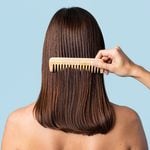How to fix damaged hair
Is your damaged hair in need of rescue? Find out how to fix it with these tips and products

Source: Web exclusive: January 2010
Dryness, dullness, weakness, breakage, out-of-control static and flyaways, and a tendency to pouf instantly in humidity yet deflate after styling’if you’re seeing all that in the mirror, fret not. You can nurse your hair back to crowning-glory health with tips from Canada’s hair guru Michael Victor, owner of Delineation Skin & Hair in Toronto.
Determine your damage type
According to Victor, also known in some circles as "the hair doctor," chemically traumatized hair needs slightly different attention from the mechanically beaten down, so you need to know what you’re dealing with.
Chemical damage comes from bleaching or lightening, perms, chemical straightening, and overexposure to chlorine. "Chemical processes break down the natural proteins in hair and weaken it," says Victor.
Mechanical damage has many more malevolent minions, and generally depletes hair’s natural moisture and resiliance. Heat styling is the biggest bully, but the beat-down gang includes snaggy past-their-prime brushes, regular backcombing, excessive exposure to wind and sun, and rough handling such as vigorous towel-rubbing and brushing when hair is wet.
"I see a lot of damage from using tools that are too hot for the person’s hair type," adds Victor. "Everyone wants dryers and irons that go to 400 degrees-plus, but some hair’like fine, fragile hair’can’t take those temperatures."
Change your haircare products
Even if you don’t colour your hair, try a glaze, or semi or demi-permanent colour. These are ammonia-free formulas that coat the cuticle to make it smoother, thicker, stronger and shinier, and gradually fade without leaving roots.
Switch to a shampoo and conditioner that target your trauma type. "You need to fortify or ‘rebuild’ chemically damaged hair to stop breakage, so you want a protein or keratin reconstructor," says Victor. Try Joico K-Pak Color Therapy shampoo, conditioner and styling oil with peptides and amino acids to resurface and reconstruct damaged hair ($16.75 to $21.50; 1-800-80-JOICO or joico.com).
Parched or brittle mechanically stressed hair needs moisture rather than protein, Victor says, so look for a moisturizing or hydrating shampoo and conditioner. Try Nexxus Therappe Luxurious Hydrating Shampoo and Humectress Ultimate Hydrating Conditioner, both of which boost hair’s moisture levels with ceramides, nutrients, antioxidants and UVA/UVB protectors ($6 and $10 for 150 mL sizes; at drugstores and well.ca).
If you’re dealing with what seems like equal parts chemical and mechanical wreckage, alternate your damage-specific products.
You’ll also need a hair treatment once or twice per week. Up the benefits by wrapping hair in a plastic bag, warming with your blow-dryer and leaving on for 15 minutes to half an hour. Try Delineation Hair & Skin Essentials Mask, which is pH balanced for damaged hair, works for both kinds of damage, and can be used as a daily conditioner plus once per week as a 30-minute hair mask ($35 at delineation.ca).
Change your routine
Make friends with your natural texture. Ask your stylist for a cut that allows you to air-dry your hair without the need for much in the way of hot-iron or dryer touch ups. And get trims every six weeks until all the damage is gone.
Use only a wide-tooth comb on wet or damp hair. If you must occasionally blow-dry, straighten or curl, thoroughly blot excess moisture with a towel before turning up the heat. "Using a hot dryer on really wet hair heats the water first’it’s like boiling your hair," Victor points out. Use a microfibre hair towel, which soaks up more water than terrycloth, and faster, so you’ll need less dryer time. Try an Upper Canada Soap Micro Fiber Hair Wrap ($15; uppercanadasoap.com for retailers), or the Hand Dry Hair Glove, a thick microfibre-towel glove particularly good for gently scrunching wet curly hair ($22.95 for two at delineation.ca).
Always use a pre-blowdry anti-heat-damage styling product, such as John Frieda Frizz-Ease Heat Defeat Protective Styling Spray ($10.49 at drugstores and well.ca).
Choose tools appropriate for your hair texture and strength. If you’re a fine-haired type, consider hot rollers instead of a curling iron, and stick with a drugstore dryer that hits the under-$50 mark. "The coarser the hair, the more heat it can take’if it’s healthy," says Victor. And whatever your hair type or strength, do not position your blowdryer too close to your hair.
Victor makes the too-close point by holding up a blow-dryer and asking for volunteers to press a palm against the mouth of the nozzle. "It’s not on, but the idea freaks people out and makes them hesitate," he says. “When you blowdry with the nozzle right against the hair, all you get is concentrated heat that fries the cuticle and melts your brush. Pull the dryer back a bit and you get airflow; that’s what you need to dry hair.”
Maintainance and prevention
Pay attention to your hair’s progress. About six weeks into its recovery program, it will likely require another change. "If your hair starts to feel weighed down, or you stop seeing improvement, it’s time to cut back," explains Victor. It’s not that the regimen has stopped working; rather, it’s time to switch to a maintenance and prevention program. That means sticking close to your natural colour (highlighting a little around the face is easier on hair than doing your whole head) and routinely using a protective styling product before occasional heat styling.
"If you go back to all your old habits, you’ll end up at square one again," Victor points out.
Don’t miss out! Sign up for our free weekly newsletters and get nutritious recipes, healthy weight-loss tips, easy ways to stay in shape and all the health news you need, delivered straight to your inbox.




